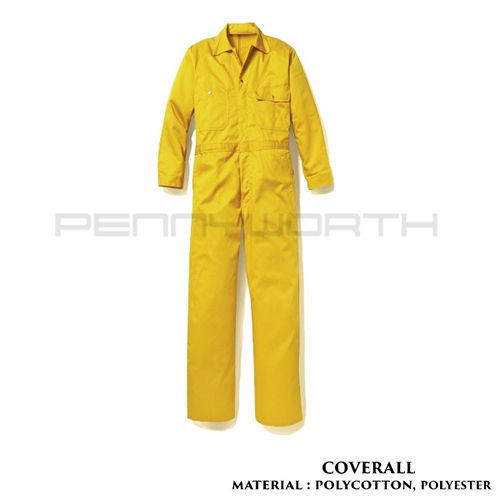Product Description
This Coverall Safety Uniform is a one-piece, loose-fitting safety uniform that is also referred to as workwear, overalls, coveralls, boiler suits, and other terms. It is primarily utilized in industries, redevelopment projects, oil fields, refineries, and other similar facilities. Oil spills, dirt skin wounds, and skin contamination are all avoided, keeping your skin protected. This coverall safety uniform is a versatile piece of safety equipment. Only after wearing it over your entire body should you judge how well it fits.
A coverall safety uniform, often simply referred to as "coveralls," is a type of protective clothing worn to ensure the safety and hygiene of individuals working in various industries and environments. Coveralls are designed to provide full-body protection against hazards such as chemicals, contaminants, dirt, heat, and flames. They are commonly used in industries such as manufacturing, construction, agriculture, healthcare, and more.
Key features and aspects of coverall safety uniforms include:
1. Full-body Coverage: Coveralls typically cover the entire body from neck to ankles, and some may also include a hood or head protection.
2. Material: They are made from various materials depending on the intended use. These can include flame-resistant materials, chemical-resistant materials, and lightweight fabrics for comfort and breathability.
3. Closure: Coveralls often have a front zipper or snap-button closure, making it easy to put on and take off.
4. Pockets: Many coveralls come equipped with multiple pockets for tools, equipment, or personal items.
5. Elastic Cuffs and Ankles: Elasticized cuffs at the wrists and ankles help provide a snug fit and prevent debris or chemicals from entering the suit.
6. Visibility: Some coveralls are designed with high-visibility colors and reflective strips to enhance the wearer's visibility, particularly in low-light conditions.
7. Hazard Protection: Depending on the industry, coveralls may offer protection against specific hazards, such as flame retardancy, chemical resistance, or abrasion resistance.
8. Disposable vs. Reusable: Coveralls can be disposable or reusable. Disposable coveralls are often used for short-term tasks, while reusable ones are designed for more extended use and can be laundered and reused.
9. Sizing: Proper sizing is crucial to ensure comfort and protection. Ill-fitting coveralls can reduce mobility and effectiveness.
10. Customization: Some coveralls may be customizable with company logos, names, or other identification.
11. Regulations: Depending on the industry and location, there might be specific regulations and standards governing the use of coveralls to ensure worker safety.
FAQ:
Q. What is a coverall safety uniform?
Ans: A coverall safety uniform is a type of protective clothing that covers the entire body, providing defense against various hazards such as chemicals, contaminants, heat, and flames. It's commonly used in industries where worker safety is crucial.
Q. Who uses coverall safety uniforms?
Ans: Coveralls are used by workers in a wide range of industries, including manufacturing, construction, healthcare, agriculture, oil and gas, mining, and more.
Q. What are coveralls made of?
Ans: Coveralls can be made from various materials, including flame-resistant fabrics, chemical-resistant materials, and lightweight, breathable fabrics for comfort. The choice of material depends on the specific hazards in the workplace.
Q. What hazards do coveralls protect against?
Ans: Coveralls are designed to protect against hazards such as chemical spills, flames, contaminants, dirt, abrasion, and certain workplace-specific dangers.
Q. Are coveralls one-size-fits-all?
Ans: No, coveralls come in various sizes to ensure a proper fit. Ill-fitting coveralls can hinder movement and reduce the effectiveness of protection.
Q. Can coveralls be customized?
Ans: Yes, some coveralls can be customized with company logos, names, and other identification for branding or easy identification of workers.
Q. Are there regulations governing the use of coveralls?
Ans: Depending on the industry and region, there might be regulations and standards that dictate the use of specific types of coveralls to ensure worker safety.
Q. Are coveralls disposable or reusable?
Ans: Coveralls can be both disposable and reusable. Disposable coveralls are often used for short-term tasks, while reusable ones can be laundered and used multiple times.
Q. How do I ensure the right fit for coveralls?
Ans: Proper sizing is essential. When selecting coveralls, refer to sizing charts provided by manufacturers and consider the mobility required for the tasks your workers will perform.
Q. What is the difference between coveralls and overalls?
Ans: Coveralls provide full-body coverage, including the arms, whereas overalls typically consist of pants with shoulder straps and a bib front. Overalls are more common in some industries like farming and may not offer the same full-body protection as coveralls.
Q. Can coveralls be worn over regular clothing?
Ans: Yes, coveralls are designed to be worn over regular clothing to provide an additional layer of protection.
Q. How do I care for reusable coveralls?
Ans: Care instructions vary based on the material. Generally, follow the manufacturer's guidelines for washing, drying, and storing reusable coveralls to maintain their effectiveness and durability.
Q. Are coveralls comfortable to wear for extended periods?
Ans: Modern coveralls are designed with comfort in mind, including features like breathable fabrics, elastic cuffs, and ergonomic designs. However, comfort can vary based on the specific material and design of the coveralls.
Q. Do coveralls come with any warranties?
Ans: Some manufacturers may offer warranties or guarantees on the performance and durability of their coveralls. It's advisable to check with the manufacturer for specific details.
Q. Where can I purchase coverall safety uniforms?
Ans: Coveralls are available from various sources, including specialized safety equipment suppliers, online retailers, and stores that cater to specific industries.


 English
English Spanish
Spanish French
French German
German Italian
Italian Chinese (Simplified)
Chinese (Simplified) Japanese
Japanese Korean
Korean Arabic
Arabic Portuguese
Portuguese
